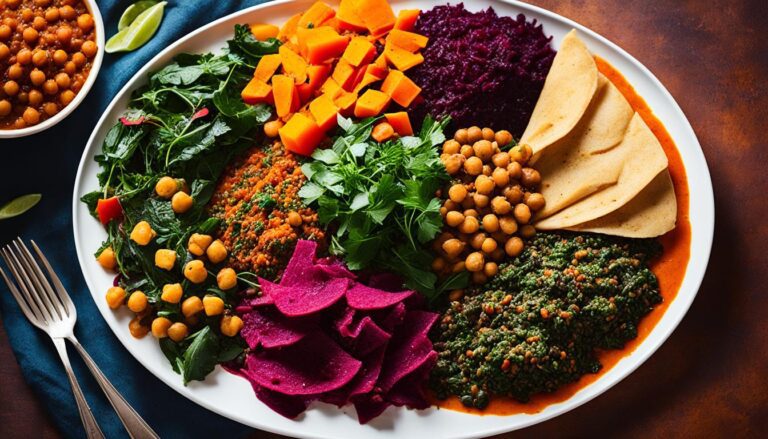Is Ethiopian Food High in Calories?
When it comes to exploring diverse cuisines, Ethiopian food often stands out for its vibrant flavors and unique dining experience. But have you ever wondered if this delicious cuisine is high in calories? Does indulging in Ethiopian dishes mean sacrificing your healthy eating habits? Join us as we dive into the nutritional aspects of Ethiopian food to find out the truth behind this culinary delight.
At first glance, the rich spices and hearty stews may lead you to believe that Ethiopian food is calorie-dense. However, appearances can be deceiving, and it’s important to uncover the facts before making assumptions. So, is Ethiopian food truly high in calories, or is there more to this flavorful cuisine than meets the eye?
Key Takeaways:
- Ethiopian food is known for its diverse flavors and communal dining experience.
- Traditional Ethiopian dishes often include a mix of grains, vegetables, and spices.
- While certain dishes may have higher calorie content, Ethiopian cuisine generally offers a balanced mix of nutrients.
- Emphasizing whole grains, legumes, and vegetables, Ethiopian food can provide health benefits beyond calorie count.
- Portion size and specific dish choices play a role in managing calorie intake.
Overview of Ethiopian Cuisine
Before we dive into the calorie content of Ethiopian food, let’s take a moment to explore the vibrant world of Ethiopian cuisine. Known for its diverse flavors and rich history, Ethiopian cuisine offers a unique culinary experience.
At the heart of Ethiopian dining is the traditional communal plate called “injera.” This spongy flatbread serves as a foundation for various dishes, creating a shared and interactive dining experience.
One of the defining features of Ethiopian cuisine is the combination of grains, spices, vegetables, and meats in their dishes. This harmonious blend of ingredients results in aromatic and flavorful meals that cater to different tastes and dietary preferences.
The cuisine showcases a wide range of dishes, including stews, curries, and spiced meats. Vegetarian and vegan options are also abundant, making Ethiopian cuisine accessible to a diverse audience.
Whether you’re a fan of aromatic spices, hearty stews, or the unique flavors of injera, Ethiopian cuisine promises an unforgettable culinary experience. Now that we have a general overview, let’s delve deeper into the ingredients commonly used in Ethiopian food and their nutritional aspects.
Typical Ingredients Used in Ethiopian Food
To understand the calorie content of Ethiopian food, it’s important to look at the typical ingredients used. Ethiopian cuisine heavily relies on a variety of ingredients that contribute to its unique flavors and nutritional profile.
One of the key components of Ethiopian dishes is lentils, which are a staple in this cuisine. Lentils are packed with nutrients and provide a good source of plant-based protein and dietary fiber.
In addition to lentils, Ethiopian cuisine incorporates a wide range of vegetables. Collard greens and cabbage are commonly used, adding both flavor and important nutrients to the dishes. These vegetables are rich in vitamins, minerals, and antioxidants, making them a valuable addition to the Ethiopian diet.
Spices play an integral role in Ethiopian cooking, with berbere and mitmita being two popular spice blends. Berbere is a fiery spice blend that typically includes chili peppers, garlic, ginger, and various other herbs and spices. Mitmita, on the other hand, is a hot and spicy blend made from chili peppers, cardamom, clove, and other aromatic spices. These spices not only enhance the taste of Ethiopian dishes but also provide potential health benefits, as many spices are known for their antioxidant and anti-inflammatory properties.
When it comes to meat, Ethiopian cuisine offers a variety of options. Chicken, beef, and lamb are commonly used in dishes such as doro wat (spicy chicken stew) and tibs (grilled meat). These meat dishes provide a source of protein and essential nutrients.
Overall, the combination of lentils, vegetables, spices, and meats used in Ethiopian cuisine creates a diverse and flavorful culinary experience while contributing to a well-rounded nutritional profile.
Calorie Content in Ethiopian Dishes
Now, let’s address the main question – is Ethiopian food high in calories? While Ethiopian cuisine can vary in terms of calorie content depending on the specific dishes and cooking methods, it generally offers a balanced mix of nutrients. Many traditional Ethiopian dishes are rich in plant-based ingredients, which means they tend to be lower in calories compared to dishes that heavily rely on processed or high-fat ingredients. However, certain dishes like doro wat (spicy chicken stew) or kitfo (minced raw meat) can have higher calorie content.
When it comes to Ethiopian cuisine, the calorie content can be influenced by the cooking method and portion size. By using traditional cooking techniques like simmering and steaming, Ethiopian dishes can retain their nutritional value while keeping the calorie count in check. The communal dining style, where dishes are served on a large shared plate called “injera,” also promotes portion control.
One must not forget the importance of spices in Ethiopian cooking. Spices like berbere and mitmita not only add rich flavors but can also enhance metabolism, potentially helping to burn calories.
When indulging in Ethiopian cuisine, it’s worth noting that the diversity of dishes allows for a range of choices with varying calorie content. Opting for plant-based dishes, such as lentil stews and vegetable curries, can be a healthier option. It’s all about balance and making mindful choices while enjoying the unique flavors of Ethiopian food.

Exploring the Nutritional Benefits
In addition to the calorie content, Ethiopian food offers numerous nutritional benefits. It is known for its use of whole grains, legumes, and fresh vegetables, making it a good source of dietary fiber, vitamins, and minerals. These nutrient-rich ingredients contribute to maintaining a healthy diet and can support weight management.
Furthermore, traditional Ethiopian cooking techniques involve minimal use of oil, focusing instead on the flavors brought out by the spices and ingredients. This cooking style can be beneficial for those watching their fat intake or following a heart-healthy diet.
In the next section, we will delve deeper into the various health benefits that Ethiopian cuisine offers, as we continue our exploration of this vibrant and nutritious culinary tradition.
Health Benefits of Ethiopian Food
Beyond its delicious flavors and vibrant cultural significance, Ethiopian food offers numerous health benefits. The traditional Ethiopian cuisine places a strong emphasis on wholesome ingredients, making it a nutritious choice for those seeking a balanced diet.
The rich use of whole grains, such as teff, barley, and sorghum, ensures a good source of dietary fiber, which can aid digestion and promote a healthy gut. These grains provide sustained energy and help maintain a feeling of fullness, supporting weight management goals.
Ethiopian dishes also incorporate an abundance of legumes, like lentils and chickpeas, which are excellent sources of plant-based protein. These legumes are not only low in fat but also high in essential nutrients like iron and folate, promoting overall well-being and supporting healthy blood circulation.
In addition, Ethiopian cuisine celebrates a variety of vegetables, including aromatic collard greens, earthy cabbage, and flavorful tomatoes. These vegetables are packed with essential vitamins, minerals, and antioxidants, which contribute to a strong immune system and promote overall vitality.
One unique aspect of Ethiopian cooking is the use of a variety of spices, such as berbere and mitmita. Apart from adding depth of flavor, these spices offer several health benefits. Many Ethiopian spices have anti-inflammatory properties and are rich in antioxidants, which can help combat oxidative stress, lower the risk of chronic diseases, and promote overall well-being.
Another health-conscious aspect of Ethiopian cooking is the minimal use of oil. Unlike some other cuisines that rely heavily on greasy or fried dishes, Ethiopian food focuses on using minimal oil in its cooking methods. This lower fat content can be especially beneficial for individuals looking to manage their fat intake and maintain heart health.
Ethiopian Food and a Balanced Lifestyle
By incorporating Ethiopian food into your diet, you can enjoy a variety of health benefits while savoring the unique flavors of this culinary tradition. From the nutritious combination of whole grains, legumes, and vegetables to the beneficial spices and minimal oil usage, Ethiopian cuisine offers a well-rounded approach to nourishment.
Embrace the diversity of Ethiopian food, experiment with different dishes, and do not forget to try the iconic injera, a spongy Ethiopian flatbread that accompanies many meals. The nutritional value and health benefits of Ethiopian food make it a delightful addition to a balanced lifestyle.

Conclusion
In conclusion, Ethiopian food is a flavorful and diverse cuisine that generally offers a balanced mix of nutrients. While some dishes may have higher calorie content, the overall nutritional profile of Ethiopian food is often healthier compared to many other cuisines.
By incorporating staple ingredients like lentils, vegetables, and spices, Ethiopian cuisine provides a variety of health benefits. These dishes are rich in dietary fiber, vitamins, and minerals, contributing to a well-rounded diet. Additionally, the minimal use of oil in cooking makes Ethiopian food a good choice for those watching their fat intake.
However, it is essential to be mindful of portion sizes and the specific dishes chosen to manage calorie intake effectively. Despite any variations in calorie content, embracing the diverse flavors of Ethiopian food can be a delicious and nutritious addition to one’s culinary repertoire.







